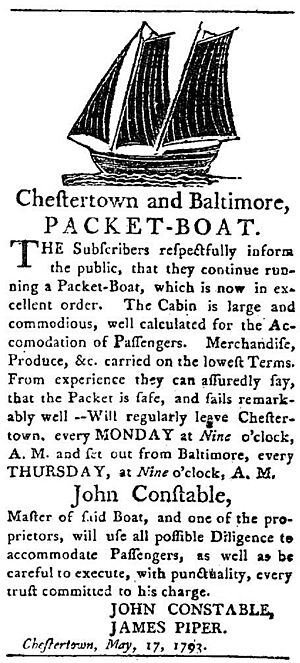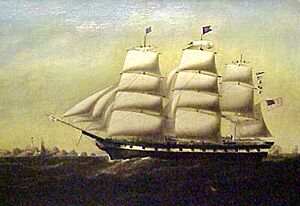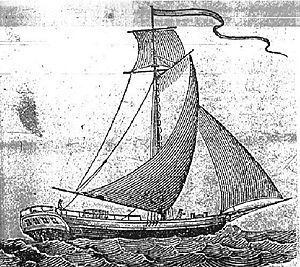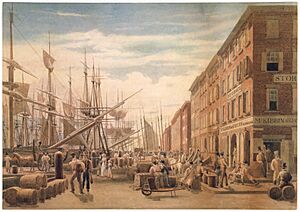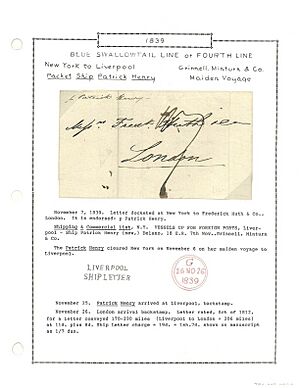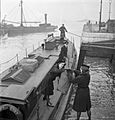Packet boat facts for kids
Packet boats were special boats used a lot in the 1700s and 1800s. They were like early delivery services! These boats carried mail, people, and goods on a regular schedule. You'd find them on rivers and canals in Europe and North America. Some even used steam engines to move faster.
In the United States during the 1800s, steam-powered packet boats were very important. They traveled on big rivers like the Mississippi and Missouri. They helped supply forts and trading posts and moved people around.
Packet ships were bigger versions used on the Atlantic Ocean. From the 1700s, they sailed between Great Britain and its colonies. This service was often called the packet trade.
Contents
History of Packet Boats
Packet boats have a long history, starting in Europe in the 1600s. They first carried mail along the coast. Soon, they started adding small, simple spaces for passengers. These early trips offered basic transport, a place to cook, drinking water, and a spot to sleep. The water sometimes tasted funny because of what the barrels held before!
Later on, these boats offered scheduled trips. But how long a journey took really depended on the weather.
In 1724, the writer Daniel Defoe even wrote about them in his book Roxana: The Fortunate Mistress. By the mid-1700s, the King of England had 15 packet vessels. They ran a weekly service to Europe and Ireland. These boats were so important that the very first boat built in the new colony of New South Wales in 1789 was a packet boat called the Rose Hill Packet.
Over 200 years, packet boats came in many shapes and sizes. They included schooners, sloops, brigs, and even the super-fast clipper ships. Sometimes, private ships were hired to do the job during wars. People loved hearing about "record passages" – when a boat made a trip super fast. The captain and crew often became famous in the news! This race for speed helped improve how ships were built.
In 1863, during the American Civil War, a packet boat named Marshall carried the body of Confederate General Stonewall Jackson. It took him from Lynchburg to his home in Lexington, Virginia, for burial.
Canal Packet Boats in America
American canal packet boats were usually long and narrow. They were about 14 feet (4.3 meters) wide to fit in canals. But they could be 70 to 90 feet (21 to 27 meters) long! When the Erie Canal opened in New York in 1825, many people wanted to travel on it.
These canal packet boats had cabins for up to 60 passengers. Unlike ocean-going ships, these boats were pulled by teams of two or three horses or mules. Traveling by canal boat was much faster and more comfortable than going by land. It cut journey times in half!
Travelers could go from New York City to Buffalo in about ten days. This trip used a mix of sailing ships and packet boats. Many people used these boats to move to Ohio and other parts of the Midwest. They were also key for travel within Upstate New York on smaller canals. Packet boats were also popular on the James River and Kanawha Canal in Virginia.
Atlantic Packet Ships
Packet ships were like the ancestors of today's huge ocean liners. They were the first ships to sail between American and European ports on a regular schedule. The first company to do this was the Black Ball Line. It started on January 1, 1818. They offered a monthly service between New York and Liverpool with four ships.
Other companies soon followed. In 1821, the Red Star Line began. In 1822, Fish, Grinnell, & Co. started the Swallowtail Line. By 1825, ships were advertised to leave New York on the 8th and Liverpool on the 24th of each month. However, their actual schedules often changed a lot due to weather.
Mail Steamers
Mail steamers were steamships that carried mail across oceans or between islands. This was mostly in the 1800s and early 1900s. During this time, sending a letter became cheap enough for regular people to send mail far away. Besides mail, most mail steamers also carried passengers or cargo. The money from mail alone usually wasn't enough to pay for the trip.
However, carrying mail had a big advantage for a steamship. Its arrival would be announced in newspapers beforehand. This gave the ship "free advertising" for passengers or cargo. Usually, mail from these steamers went to the post office. Sometimes, if there were problems, a local service would deliver the mail for an extra fee.
Rules for Mail
Mail carried by these steamers, sometimes called "paquebot mail," had special rules. These rules came from the governments involved and the Universal Postal Union (UPU). The UPU set these rules at its Vienna Conference in 1891.
Aircraft Named After Packet Boats
The C-82 Packet was a cargo airplane with two engines and two tail booms. It was built by Fairchild Aircraft. It was named as a way to honor the old packet boats. The United States Army Air Forces and later the United States Air Force used this plane after World War II.
Packet Boats and News
Getting information quickly was super important in the 1800s. Businesses needed to know about trade, markets, and legal papers fast. People also wanted personal letters and political news. Packet ships, especially those in the packet trade, became the main way to spread information. They were like the internet of their time! They also helped journalism grow.
For example, in January 1840, the American Packet ship Patrick Henry arrived early. It beat other ships to deliver news from Europe to eager American readers. The Morning Herald newspaper in New York reported it on February 1. They said they got the news an hour before other papers. They even printed a special edition to share the news with the huge crowd outside their office.
The news was advertised as "Ten Days Later From England—Highly Important." It included stories about war plans, Queen Victoria's marriage, and government meetings.
The Patrick Henry had a very fast trip. It sailed for nine days before hitting strong westerly winds. These winds then lasted for a while.
Faster communication was vital for business. Quicker information meant money could move faster, which helped world trade.
In 1840, the Patrick Henry was one of twenty sailing packet ships on the New York–Liverpool route. It was known for being one of the fastest. However, the speed of these ships didn't really improve after steamships came along in the late 1830s.
Traveling west across the Atlantic was very risky. About one out of every six packet ships was completely lost at sea. This means that out of 6,000 trips, about 22 ended in shipwrecks. More than 600 British ships of all kinds were lost each year between 1833 and 1835, and again between 1841 and 1842. Between 1,450 and 1,560 lives were lost each year.
By 1839, when the Patrick Henry made its first trip, packet captains were taking more risks. This was because steamships were starting to compete with them. Most shipwrecks happened when sailing ships and steamships were competing the hardest. This was a big problem for sending mail, business news, and journalism.
Between 1838 and 1847, 21 mail-carrying ships were lost on the North Atlantic route. That's about two ships lost each year. Most of these were American sailing packets. Six of the ships just disappeared with everyone on board. It's interesting that two out of three wrecks happened in November to February. This shows that captains took too many risks, especially during rough winter trips. To make sure important business information got across the Atlantic, people often sent two copies of everything. This was common during this time of change. Sending duplicates also helped make sure the information arrived as fast as possible.
Even after steamships started, sailing ships still carried most of the mail, especially going east, for about ten years.
Even though sailing packets got much bigger, their speed didn't really increase after steamships arrived in the late 1830s. After 1835, there were no signs of speed improvements.
Another sign that sailing packets were losing their top business (mail, valuable goods, and cabin passengers) was that they stopped caring as much about being on time. In the mid-1840s, the American sailing packets were not as reliable for mail service as people expected.
Images for kids
-
Cologne, the Arrival of a Packet Boat in the Evening by Turner, 1826
See also
- Allan Line Royal Mail Steamers
- Black Ball Line (trans-Atlantic packet)
- Flagey building in Brussels, nicknamed "Packet Boat"
- Ocean liner
- Pony Express
- Postal history
- Royal Mail Ship


